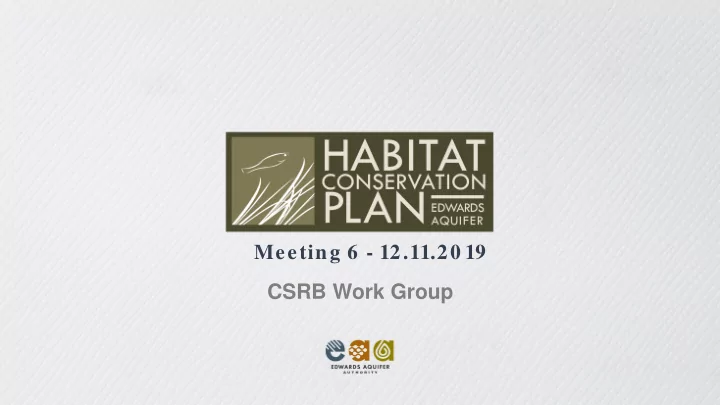

Meeting 6 - 12.11.20 19 CSRB Work Group
EAHCP CSRB WG Charge Charge Topic Topic Question Is the current cotton lure sampling methodology an appropriate means to monitor abundance at a locale? Cotton lure If not, what sampling methodologies exist that would provide a better proxy of sampling abundance at a locale? methodology If the previous two questions cannot be adequately answered without additional study, what would be an appropriate study to answer the questions? What changes are recommended for the Biological monitoring sampling program? Biological What are the stated goals behind those changes? monitoring, Refugia What changes are recommended for Refugia removal efforts? What are the stated collections, and goals behind those changes? Applied Research collections Are the current and proposed levels of physical activity in the CSRB habitat protective of the species? If not, what level of activity is appropriate? Are the current population and habitat LTBGs for the CSRB appropriate? What are the criteria for more appropriate goals? Long-term What is an appropriate means to monitor the habitat quality goal? biological goals How can Biological monitoring, Refugia efforts, and Applied Research studies be used to establish new LTBGs?
Cotton lure sampling methodology Recommendations • Continue using cotton lure for CSRB biological monitoring and refugia removals. • Conduct cotton lure mesocosm experiment using methodology developed during work group meetings. • EAHCP goal is to conduct and finalize experiment in 2020.
Biological monitoring, Refugia and Applied Research collections Recommendations • Continue historical Biological monitoring program at 3 locations, twice a year, 10 lures per survey, repeated sampling of individual orifices. • Conduct two Comal system-wide occupancy and population studies prior to 2028. • Potential survey years are 2022 and 2025. • It is anticipated study design will be contracted out and raw data from the Nowlin 2019 population study will be used to aid design.
Biological monitoring, Refugia and Applied Research collections Recommendations • Reduce Refugia standing stock numbers to 150 adults (75 at each station). • Allow Refugia collections to retain 100% of beetles captured on a lure. • Alternate spring orifices between Refugia collection events such that the same spring orifice is not sampled on consecutive collection events. • Do not overlap Refugia collection locations with Biomonitoring locations.
CSRB Long-Term Biological Goals • Maintain present Long-Term Biological Goals. • Revisit Long-Term Biological Goals after population studies and in-situ cotton lure studies have been completed.
CSRB future meetings • Conduct an annual meeting to review progress and discuss current CSRB topics December 9 th 2020 – location TBD • • Potential topics: 2019 and 2020 Biomonitoring surveys • • Refugia collections, captive life spans, and standing stock numbers • TSU population survey
Recommend
More recommend